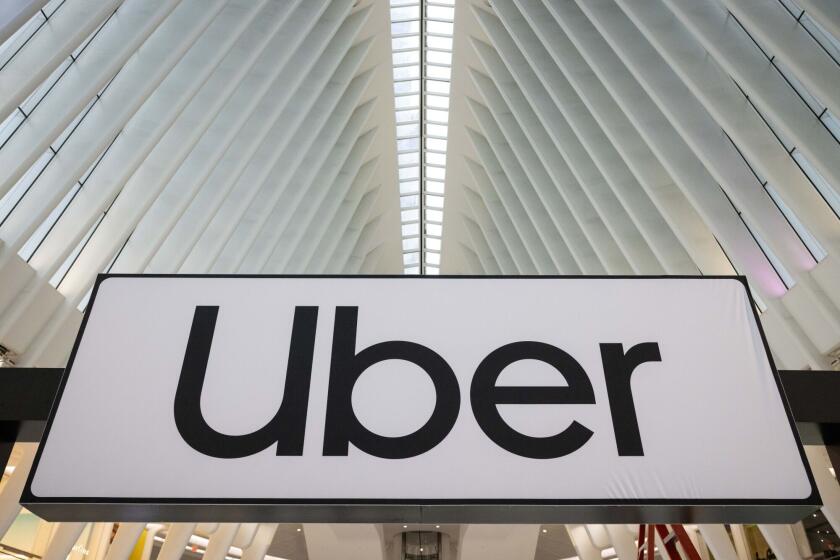Upgrades at LAX face new hurdles
- Share via
Amid one of the worst economic downturns in the history of the airline industry, Los Angeles International Airport is shedding passengers faster than its peers across the country, threatening the revenue stream needed to modernize its aging facilities.
In September, international and domestic travel through LAX declined 7.3% compared with the same time last year. Cargo plummeted about 17%. This is the biggest monthly drop in traffic this year, and even more declines are expected.
If the airline prophets are correct, LAX could see between 53 and 55 million travelers next year, down from 62.4 million in 2007 and 67.3 million in 2000. One prominent aviation consultant predicts that by 2014, LAX will have 10.5% fewer passengers than today, largely because it is not a home base for any airline.
Yet airport leaders are confident they can deliver needed improvements to the Tom Bradley International Terminal by 2012 and set the stage for the overall modernization of LAX, which has been planned for 11 years under three mayoral administrations.
“We can afford to do this. The downturn is not going to slow our progress,” said Gina Marie Lindsey, director of Los Angeles World Airports, which operates LAX, Ontario International Airport and Palmdale Regional Airport. “In the near term, we are doing worse than other airports, but that will not be the case long-term.”
The downturn has caused airports across the country to postpone building terminals, gates and runways. Some airline executives have come out against new construction, and projects that are under way have run into financing problems. Chicago’s O’Hare International Airport, for example, has been unable to sell bonds to help finance an $8-billion realignment of its runways.
“It is time for all airports and airlines to sharpen their pencils,” said John Heimlich, chief economist for the Air Transport Assn., the industry’s lobbying arm. “They need to revisit and rethink what projects will pay off, the ones that won’t and the ones that should be deferred.”
How LAX proceeds is critical. With tens of millions of business and leisure travelers a year, LAX is an economic engine for the region. If officials raise fees too much to fund a modernization effort, it could drive carriers to airports with lower costs, such as San Francisco International.
Aer Lingus and Air India have discontinued service to LAX, partly because of cost concerns, airport sources say, but have kept their San Francisco operations.
Among the highest priorities is the aging Bradley complex, which serves international travelers and has not undergone a major remodeling since it opened just before the 1984 summer Olympics.
Plans call for rebuilt concourses, a center taxiway, a million additional square feet that would double the size of the building, and new gates on the west side to handle large aircraft, such as the Airbus A380 and Boeing 787 Dreamliner. The work might cost between $3 billion and $3.5 billion, according to estimates.
Lindsey said LAWA would continue planning other parts of the modernization, but those projects would probably have to wait until the economy and the airlines recover. The projects include a midfield concourse, a consolidated rental car facility, a people mover, improvements to the north runways and a passenger processing facility.
The airlines caution, however, that the improvements must be cost-effective and enhance operations without significantly raising landing fees and rents when high fuel costs and a slowing economy have pummeled their bottom lines.
They also say they will resist the desires of city leaders to create a bold architectural statement at LAX if it adds hundreds of millions of dollars to the cost of modernization without substantially improving airport efficiency.
“The Bradley building and the airport need to be modernized, but not at any cost,” said Frank Clark, who represents a trade association of international carriers at LAX. “It must be done in a way so that LAX remains competitive with other major airports. With the next generation of long-range aircraft, airlines can locate almost anywhere.”
Clark cautioned that as the industry recovers from the downturn, carriers will pay close attention to airport fees and their operational needs in deciding where to restore flights. The potential for LAX to lose out to other airports, he said, “is not a hypothetical.”
So far, planning the modernization has cost LAWA almost $260 million in consulting contracts for engineering and architectural designs -- work that has produced several plans dating to Mayor Richard Riordan’s administration.
Lindsey, appointed by Mayor Antonio Villaraigosa in June 2007, has advanced the effort, though the project and its cost have yet to be defined. She has vowed to provide new gates at the Bradley terminal by early 2012, an aggressive time frame by her own admission.
The latest concepts are set to be unveiled by Villaraigosa during a ceremony Nov. 17. On display will be an 8-by-12-foot model of the improvements and renderings of proposed building interiors.
“The mayor wants a world-class experience for air travelers and to make a long-term investment in the future of the airport,” said Jaime de la Vega, who works on aviation issues for the mayor’s office. “LAX will eventually fare well among airports globally.”
Everything is hush-hush. Lindsey, who has viewed the model and architectural renderings, declined to comment except to say, “They’re lovely.”
Though the modernization effort is progressing, it has run up against a steep decline in the airline industry and a global economic crisis that has stifled the demand for air travel at home and abroad.
To cope, airlines are dramatically cutting flights and seats, a trend that will extend into 2009, analysts say, threatening airport revenues from landing fees, terminal rents, parking and concessions -- money that would have helped pay for improvements.
At LAX, airlines expect to reduce available seats by more than 11% during the fourth quarter, compared with the fourth quarter of 2007, according to the Air Transport Assn.
During the first quarter of 2009, the airlines plan to offer almost 10% fewer seats than in the first quarter of 2007.
Michael Boyd, an airline consultant and president of Boyd Group International in Colorado, predicts that LAX will have about 10.5% fewer passengers from 2008 to 2014, despite some recovery in the industry starting in 2010.
“I don’t see anyone moving flights back into LAX right way,” said Jack Keady, an aviation consultant in Playa del Rey. The downturn “is not a short-term trend in the industry. It will take a long time to recover.”
Airport officials say fees from airlines, concession and parking revenue, seed money from an $853-million bond issue this summer and future bond issues worth several billion dollars could be used to pay for the proposed Bradley projects. Lindsey said LAWA might have to “get creative” with financing, but she declined to provide details.
She also disputed the dire forecasts for LAX, which she described as speculative. Lindsey says she relies more on an analysis for the $853-million bond issue, which was released by underwriters months ago. It predicts passenger volumes will increase about 2% a year until 2014.
Alan Rothenberg, chairman of the Airport Commission, said it would be several years before the airport might have to tap the credit markets. By that time, he said, financing would probably be more available than today.
Despite the economy and recent declines in passengers, Rothenberg said the airport must proceed with improvements.
“We are trying to modernize for the next generation, not for today,” he said. “Three, four or five years doesn’t matter. For us to stop in our tracks would be foolish.”
--
More to Read
Sign up for Essential California
The most important California stories and recommendations in your inbox every morning.
You may occasionally receive promotional content from the Los Angeles Times.














